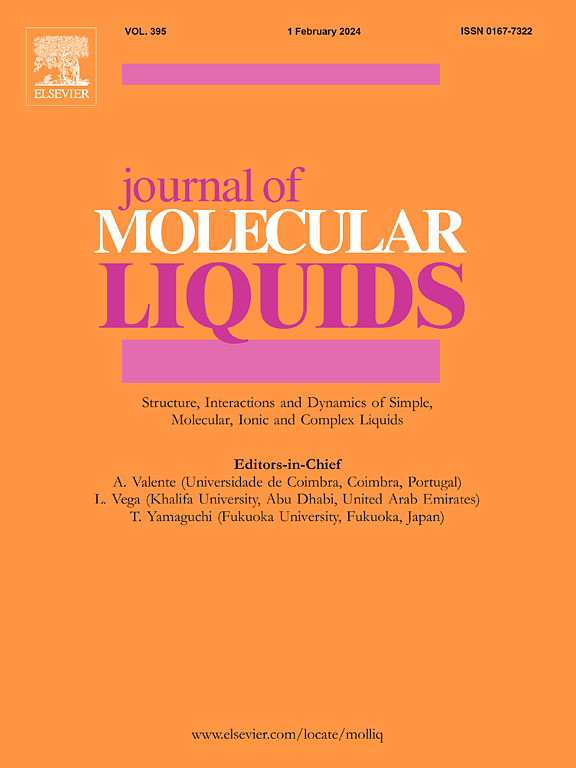二氧化碳捕获溶剂的量子化学研究
IF 5.3
2区 化学
Q2 CHEMISTRY, PHYSICAL
引用次数: 0
摘要
在MP2/6-311 ++G(d,p)理论水平上探讨了CO2与36种溶剂分子(环己烷、四氯化碳、戊烷、噻吩、甲酸、醋酸乙烯、1,4-二恶烷、水、甲醇、咪唑、二甲亚砜等)的相互作用。溶剂分子与二氧化碳的氧原子或碳原子结合。溶剂与CO2的相互作用较弱。CO2与溶剂的相互作用能(Eint)均为负值,范围为- 3.36(1,2,3-三唑/CO2配合物)至- 0.33 kcal/mol(四氯化碳/CO2配合物)。Eint的负值越大,说明溶剂分子与CO2的相互作用越强。所研究溶剂的分子静电势(MESP)最小值(Vmin-X)在−81.51(二甲亚砜)~−3.33 kcal/mol(环己烷)之间。溶剂分子的高负Vmin-X值归因于其更富电子的特性。Vmin-X与Eint具有良好的相关性,表明Vmin-X可以作为CO2与溶剂相互作用强度的度量。MESP分析还表明,由于与溶剂分子的相互作用,CO2通常变得富电子。QTAIM结果表明CO2与溶剂分子的相互作用具有非共价性质。本文章由计算机程序翻译,如有差异,请以英文原文为准。
Quantum chemical studies of solvents for CO2 capture
The interactions of CO2 with thirty-six solvent molecules (cyclohexane, carbon tetrachloride, pentane, thiophene, formic acid, vinyl acetate, 1,4-dioxane, water, methanol, imidazole, dimethyl sulfoxide, etc.) were probed at the MP2/6–311++G(d,p) level of theory. The solvent molecules were bound to either oxygen or carbon atom of CO2. The investigated solvents exhibited a relatively weak interaction with CO2. All the interaction energy (Eint) values for the interaction of CO2 with the investigated solvents were negative and in the range of −3.36 (1,2,3-triazole/CO2 complex) to −0.33 kcal/mol (carbon tetrachloride/CO2 complex). A high negative value of Eint reflects the stronger interaction between the solvent molecule and CO2. The molecular electrostatic potential (MESP) minimum (Vmin-X) values of the investigated solvents were in the range of −81.51 (dimethyl sulfoxide) to −3.33 kcal/mol (cyclohexane). A high negative Vmin-X value of the solvent molecule is ascribed to its more electron-rich character. Vmin-X displayed a good correlation with Eint, indicating that Vmin-X can be used as a measure of the interaction strength between CO2 and the solvents. The MESP analyses also showed that the CO2 usually becomes electron-rich as a result of the interaction with the solvent molecules. The QTAIM results imply a noncovalent character for the interaction of CO2 with solvent molecules.
求助全文
通过发布文献求助,成功后即可免费获取论文全文。
去求助
来源期刊

Journal of Molecular Liquids
化学-物理:原子、分子和化学物理
CiteScore
10.30
自引率
16.70%
发文量
2597
审稿时长
78 days
期刊介绍:
The journal includes papers in the following areas:
– Simple organic liquids and mixtures
– Ionic liquids
– Surfactant solutions (including micelles and vesicles) and liquid interfaces
– Colloidal solutions and nanoparticles
– Thermotropic and lyotropic liquid crystals
– Ferrofluids
– Water, aqueous solutions and other hydrogen-bonded liquids
– Lubricants, polymer solutions and melts
– Molten metals and salts
– Phase transitions and critical phenomena in liquids and confined fluids
– Self assembly in complex liquids.– Biomolecules in solution
The emphasis is on the molecular (or microscopic) understanding of particular liquids or liquid systems, especially concerning structure, dynamics and intermolecular forces. The experimental techniques used may include:
– Conventional spectroscopy (mid-IR and far-IR, Raman, NMR, etc.)
– Non-linear optics and time resolved spectroscopy (psec, fsec, asec, ISRS, etc.)
– Light scattering (Rayleigh, Brillouin, PCS, etc.)
– Dielectric relaxation
– X-ray and neutron scattering and diffraction.
Experimental studies, computer simulations (MD or MC) and analytical theory will be considered for publication; papers just reporting experimental results that do not contribute to the understanding of the fundamentals of molecular and ionic liquids will not be accepted. Only papers of a non-routine nature and advancing the field will be considered for publication.
 求助内容:
求助内容: 应助结果提醒方式:
应助结果提醒方式:


